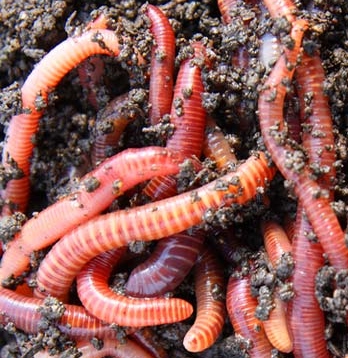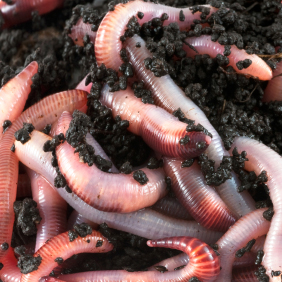Red worms: Create nutrient-rich castings
Wiki Article
Transform Your Garden With Red Wigglers: Advice
By establishing a basic worm bin and comprehending the nutritional requirements of these impressive animals, garden enthusiasts can substantially improve dirt high quality and plant health. The procedure of transforming organic waste right into abundant, productive castings is both uncomplicated and rewarding.
Benefits of Red Wigglers
Red wigglers, scientifically recognized as Eisenia fetida, are commonly hailed as nature's composting champions. These impressive worms serve several crucial benefits that can significantly boost garden wellness and efficiency. They are reliable decomposers, breaking down natural material such as cooking area scraps and lawn waste right into nutrient-rich vermicompost (red worms). This natural plant food enriches the dirt, promoting healthy and balanced plant growth and boosting soil framework.
An additional noteworthy benefit of red wigglers is their ability to minimize waste. By composting organic products that would or else contribute to land fill waste, they play a crucial role in lasting horticulture methods. Integrating these worms into your horticulture routine can lead to raised yields, much healthier plants, and a more vivid garden atmosphere, making them invaluable allies for gardeners looking for to enhance their environmental impact.
Setting Up a Worm Bin
Producing a worm bin is an essential step for anyone wanting to harness the advantages of red wigglers in their gardening initiatives. A suitable worm container can be made from different materials, consisting of plastic containers, wooden crates, or readily readily available worm containers. The initial factor to consider is size; a container that goes to the very least 2 feet wide, 3 feet long, and 1 foot deep is typically perfect for a tiny to medium number of worms.It's vital to develop a bed linens layer, making use of products such as shredded paper, cardboard, or coconut coir to supply a comfy setting for the worms. The bed linen must be moist however not soaked, looking like a moist sponge - red worms.
Place the bin in a location that maintains a consistent temperature level, preferably in between 55 ° F and 77 ° F. Avoid direct sunshine or severe cool, as these problems can hurt the worms. Once the bin is established up, permit the bed linens to go for a few days before introducing the red wigglers, ensuring they have a thriving setting in which to prosper.
Feeding Your Red Wigglers
Once the worm container is established and the red wigglers are presented, appropriate feeding ends up being essential to keeping a healthy and balanced worm population. Red wigglers grow on a diverse diet regimen, mostly consisting of cooking area scraps and organic products.When presenting food, chop the scraps into smaller sized pieces to help with quicker intake. Additionally, hide the food under a layer of bedding product to avoid fruit flies and other hassles. Monitor the feeding frequency; a basic rule is to offer food every 1-2 weeks, depending check out here upon the number of worms and the quantity of food waste generated.

Collecting Worm Spreadings
Just how can you inform when it's time to gather worm castings from your bin? The preparedness of worm spreadings is suggested by a few key indicators.An additional indication is the decrease in worm task; as the castings accumulate, worms tend to move towards fresher food sources. If you notice a decrease in worm motion and the presence of spreadings at the base of the bin, it's a clear signal that harvesting is due.
To collect, delicately scoop out the castings, taking treatment to lessen disturbance to the worms. A preferred technique involves dividing the spreadings using light; worms often tend to tunnel far from the light, permitting you to gather the castings a lot more quickly.
Collecting consistently, around every three to 6 months, guarantees a continuous supply of this nutrient-rich modification for your gardening endeavors. Keep in mind, the quality of your spreadings directly influences the health and wellness of your plants.
Utilizing Castings in Your Yard
(eisenia fetida for sale)Making use of worm spreadings in your garden can significantly enhance dirt wellness and plant development - red worms. These nutrient-rich organic fertilizers provide essential macro and trace elements, boosting the general fertility of your soil. By incorporating worm spreadings into your garden beds, you can advertise valuable microbial task, which helps in nutrient availability and boosts dirt structureTo utilize worm castings successfully, mix them right into the top couple of inches of soil prior to planting. You can develop a nutrient-dense fluid fertilizer by soaking worm spreadings in water for a week, then applying the resulting "worm tea" straight to your plants.
Worm castings likewise improve wetness retention within the dirt, reducing the need for frequent watering. Their natural pH balance makes them suitable for different plant types, from veggies to ornamentals. On a regular basis incorporating worm spreadings right into your horticulture routine can lead to durable plant growth, boosted returns, and a general much healthier garden environment. Embrace the benefits of worm castings for a thriving and lasting garden.
Conclusion
Integrating red wigglers right into yard practices provides substantial advantages, including enhanced soil fertility and enhanced plant wellness. By developing a worm container, giving appropriate food, and frequently gathering nutrient-rich spreadings, garden enthusiasts can cultivate a lasting ecosystem. The use of worm castings and "worm tea" even more adds to moisture retention and nutrient accessibility in the dirt. Inevitably, the assimilation of red wigglers promotes a productive and environmentally friendly approach to gardening, promoting overall ecological balance.Report this wiki page